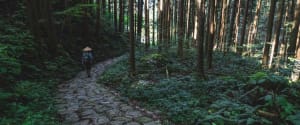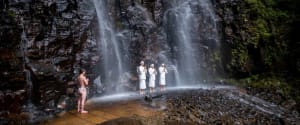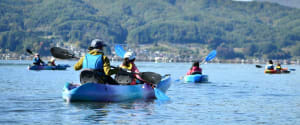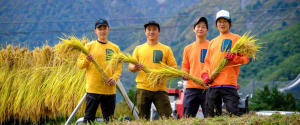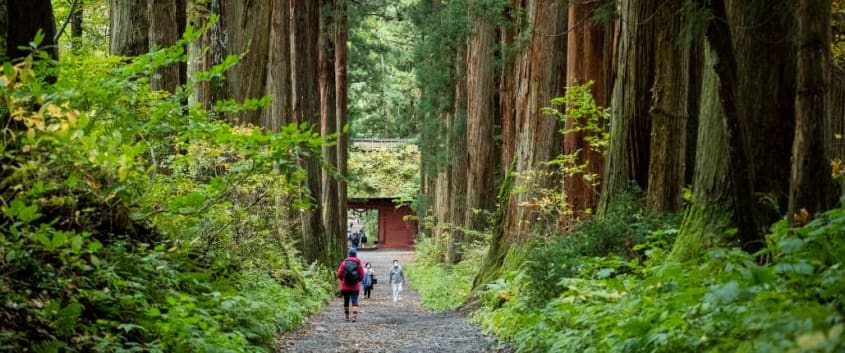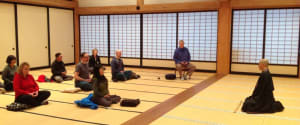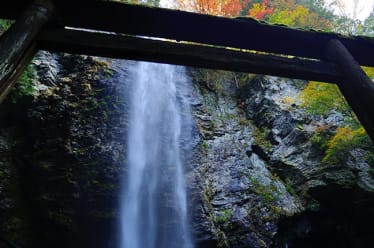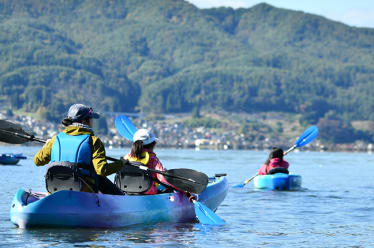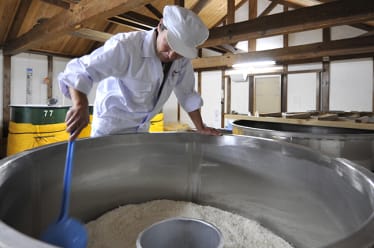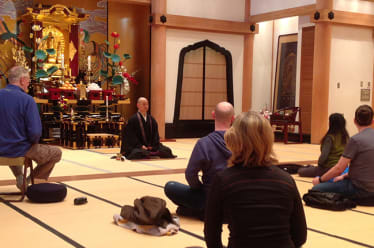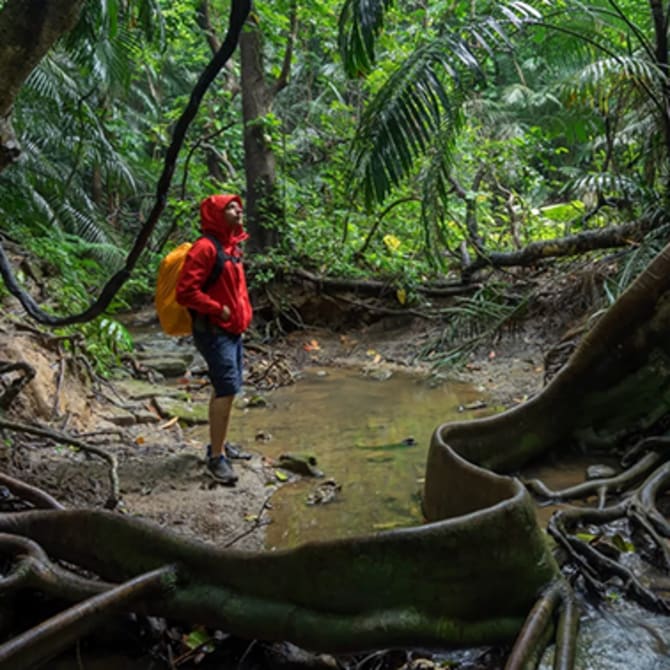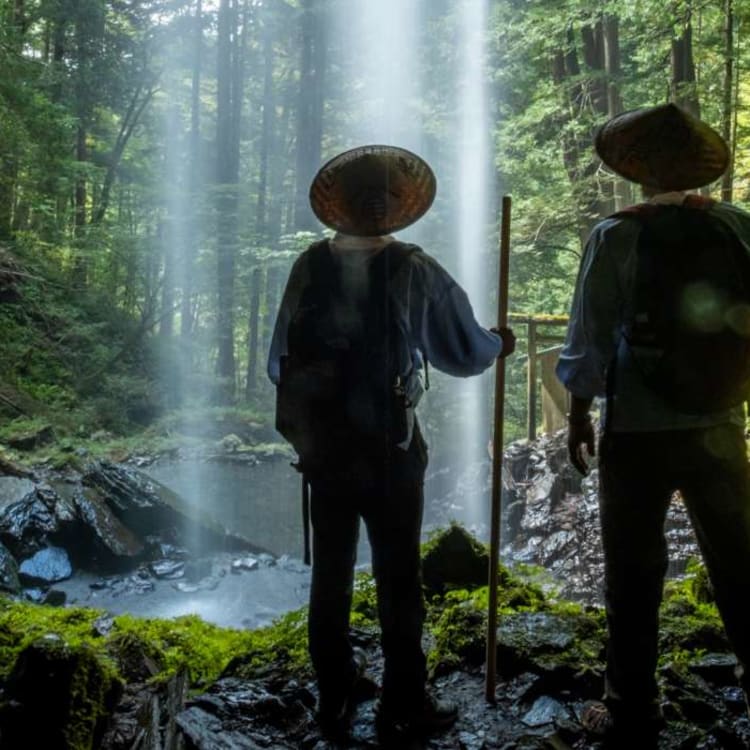
Recommended Route Hokuriku-Shinetsu (Nagano) autumn
Day 1
Trek Along the Historical Nakasendo
From Nagoya , hop on the train and bus to head towards the starting point of the trekking course—Magome. The trail stretching between the Magome and Tsumago post-towns is one of the most popular sections of the Nakasendo , a historical Edo Period (1603-1868) highway. Along the trail, you get to see wooden townscapes, stone statues and wayside shrines, tranquil waterfalls and streams—all largely unchanged since the road’s heyday. If you hire a local English-speaking guide, they can tell you about the area as you explore on foot. In addition, traditional equipment used by travelers, like kasa hats and walking sticks made of hinoki cypress, are available for rent. Halfway to Tsumago, there is a rest stop at an old farmhouse with an irori hearth for lunch, a traditional bento box with kuri-okowa (roasted chestnuts and rice). In the late afternoon, you’ll depart Tsumago for your accommodation in Kiso Fukushima. Kiso Fukushima was another post-town along Nakasendo . Enjoy a traditional Japanese hot spring lodge that faces the trail.
Day 2
Cleanse Your Body and Mind with Waterfall Meditation at MT. Ontake
On your second day, you’ll take a detour from the Nakasendo and visit an important spiritual destination that has attracted mountain ascetics for over a thousand years: Mt. Ontake . You’ll walk along the Ontake Kodo trail with an English-speaking guide. After checking out of your hotel in the morning, you’ll take a bus to Tanohara, the 7th station of the Ontake Kodo (2,180 meters), where you can see fabulous scenery of the 3,067 meters-high Mt. Ontake . (If the weather doesn’t cooperate, we’ll skip Tanohara and visit Ontake Satomiya Shrine instead.) From there, you’ll travel by bus to Omata Sansha Shrine and begin trekking. You’ll wear the traditional clothing of mountain ascetics and walk along the forest trail, visiting two waterfalls and a number of small shrines. At the end of the trail is Kiyotaki Falls, where you’ll be instructed in takigyō (waterfall meditation) and try it for yourself. This was one of the rituals that ascetic monks would perform in order to purify their bodies and minds before entering Mt. Ontake .
Next, you’ll head to a nearby lodge for lunch. You’ll eat a meal not unlike what Mountain ascetics would have eaten. They ate a strict plant-based diet, but the lodge makes their meals more accessible to the non-ascetic palate. Your instructor can go over the various ingredients and dishes that make up your meal. After lunch, you’ll take a bus to your accommodation in Kamisuwa Onsen . You’ll stay in a local hot spring hotel on the shore of Lake Suwa , where you’ll have a welcome dinner featuring an abundance of local and seasonal products.
Next, you’ll head to a nearby lodge for lunch. You’ll eat a meal not unlike what Mountain ascetics would have eaten. They ate a strict plant-based diet, but the lodge makes their meals more accessible to the non-ascetic palate. Your instructor can go over the various ingredients and dishes that make up your meal. After lunch, you’ll take a bus to your accommodation in Kamisuwa Onsen . You’ll stay in a local hot spring hotel on the shore of Lake Suwa , where you’ll have a welcome dinner featuring an abundance of local and seasonal products.
Day 3
Kayak on Lake Suwa—Famous from the Works of Hiroshige and Hokusai
The area of Lake Suwa has been known for its essential crossroads since the Edo Period, and it prospered due to the heavy traffic here. On this day, you’ll go on an adventure and explore the history and culture of the area.
After check-out in the morning, your guide will go over the day’s schedule. Then, you’ll start with a kayaking tour , where you’ll gaze upon the beautiful scenery of Lake Suwa and Mt. Fuji that once inspired the artists Hokusai and Hiroshige.
For lunch, you’ll take a tour bus to a restaurant that serves what many consider to be one of Japan’s soul foods—unagi (grilled eel). After lunch, you’ll take another bus ride to Shimosuwa, a post-town where two historical roads once met. First, on the tour is the Suwa Taisha , one of the oldest shrines in Japan, with a planned Kiyari performance. Next is the Iwanamike, the former principal inn (or honjin) of the post town with matcha tea and Japanese wagashi in the gardens.
Your last activity will be at the neighboring Kamisuwa post-town, a 15-minute bus ride away, where you’ll visit Miyasaka Brewery . Established during the Edo Period, it has produced sake for hundreds of years and is known throughout Japan for its Masumi brand. At the brewery, you have the chance to taste-test sake while listening to a talk from the head brewer. Finally, you’ll take a bus from Suwa to your next accommodation in Hakuba .
After check-out in the morning, your guide will go over the day’s schedule. Then, you’ll start with a kayaking tour , where you’ll gaze upon the beautiful scenery of Lake Suwa and Mt. Fuji that once inspired the artists Hokusai and Hiroshige.
For lunch, you’ll take a tour bus to a restaurant that serves what many consider to be one of Japan’s soul foods—unagi (grilled eel). After lunch, you’ll take another bus ride to Shimosuwa, a post-town where two historical roads once met. First, on the tour is the Suwa Taisha , one of the oldest shrines in Japan, with a planned Kiyari performance. Next is the Iwanamike, the former principal inn (or honjin) of the post town with matcha tea and Japanese wagashi in the gardens.
Your last activity will be at the neighboring Kamisuwa post-town, a 15-minute bus ride away, where you’ll visit Miyasaka Brewery . Established during the Edo Period, it has produced sake for hundreds of years and is known throughout Japan for its Masumi brand. At the brewery, you have the chance to taste-test sake while listening to a talk from the head brewer. Finally, you’ll take a bus from Suwa to your next accommodation in Hakuba .
Day 4
Harvest Rice and Hang Out with Farmers in Hakuba
After having breakfast at your accommodation, we head to the rice paddies with your guides for the day. They will tell you about the area’s yukigata (snow shape) tradition and the significance they held to local farmers, as well as the basics of rice cultivation in Japan. For your rice-harvesting experience, you even get to use a traditional kama scythe to cut the stalks and hang them out to dry.
For lunch, you’ll make your own hotpot meal outdoors using local rice and vegetables under the farmers’ supervision. In the event of rain, the rice harvesting will be replaced with a visit to a local museum where you’ll make your hotpot indoors instead. In the afternoon, take some time to relax. Your guide will introduce some activities in Hakuba for those interested.
For dinner, enjoy a traditional style of charcoal grilling, robatayaki-style meal of local produce and fresh seafood from the Sea of Japan at a renovated storage house. While you dig into your meal, a storyteller will immerse you in local folktales. Here, you can take in the atmosphere of a former post-town along the Chikuni Kaido, which served as a trade route connecting Japan’s mountainous regions to the Sea of Japan.
For lunch, you’ll make your own hotpot meal outdoors using local rice and vegetables under the farmers’ supervision. In the event of rain, the rice harvesting will be replaced with a visit to a local museum where you’ll make your hotpot indoors instead. In the afternoon, take some time to relax. Your guide will introduce some activities in Hakuba for those interested.
For dinner, enjoy a traditional style of charcoal grilling, robatayaki-style meal of local produce and fresh seafood from the Sea of Japan at a renovated storage house. While you dig into your meal, a storyteller will immerse you in local folktales. Here, you can take in the atmosphere of a former post-town along the Chikuni Kaido, which served as a trade route connecting Japan’s mountainous regions to the Sea of Japan.
Day 5
Walk the Togakushi Kodo Trail—a Haunt of Mountain Ascetics and Ninja
After eating breakfast at your accommodation and listening to a short briefing from your guide, you’ll take a bus to spiritual Mt. Togakushi . At the foot of Mt. Togakushi are five shrines that combine to form Togakushi Shrine: the Okusha, Chūsha, Hōkōsha, Kuzuryūsha, and Hinomikosha. They are connected by the Togakushi trail, which was frequented by mountain ascetics and pilgrims. You’ll walk along this historical and spiritual trail and take in Togakushi ’s tranquil atmosphere with all of your senses.
Togakushi soba is one of Japan’s Three Famous soba varieties, so a trip here wouldn’t be complete without trying it for yourself. For lunch, enjoy the delicate flavor of soba noodles made with local buckwheat flour and Togakushi spring water.
After trekking and lunch, you get to experience a display of Togakure Ninpo, a form of ninja martial arts, developed over 800 years ago in Togakushi , at the Togakushi Ninja Museum and Ninja Trick House.
Togakushi soba is one of Japan’s Three Famous soba varieties, so a trip here wouldn’t be complete without trying it for yourself. For lunch, enjoy the delicate flavor of soba noodles made with local buckwheat flour and Togakushi spring water.
After trekking and lunch, you get to experience a display of Togakure Ninpo, a form of ninja martial arts, developed over 800 years ago in Togakushi , at the Togakushi Ninja Museum and Ninja Trick House.
Day 6
Seek Enlightenment at the 1,400-Year-Old Zenkoji Temple
For those willing to wake up a little early, you can watch Zenkoji Temple’s morning service and then participate in zazen meditation. Your guide will first take you to the temple to witness the service, which has been held daily for hundreds of years. And after that, you’ll enter Daikanjin Temple and perform zazen meditation with the instruction of one of the temple’s monks. During meditation, you’ll have the opportunity to recenter yourself after a long and rewarding tour of central Japan.
Then you’ll return to the temple lodge and have a filling shōjin breakfast. After a briefing by your guide, you’ll ride the Hokuriku bullet train towards Tokyo as you say your farewells to the beautiful lands of Nagano .
Then you’ll return to the temple lodge and have a filling shōjin breakfast. After a briefing by your guide, you’ll ride the Hokuriku bullet train towards Tokyo as you say your farewells to the beautiful lands of Nagano .






















































